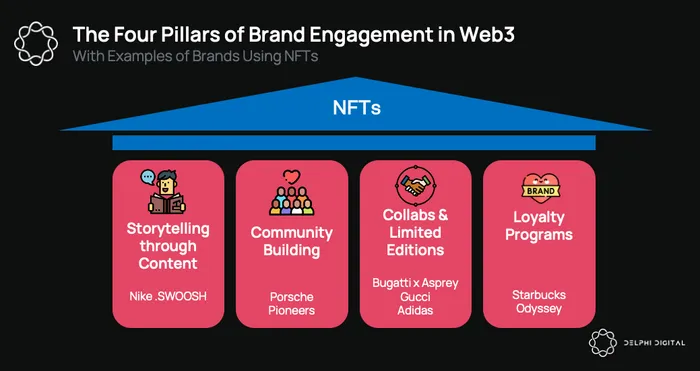Below is the executive summary of our recent NFT report:
- Web3 and NFTs is a green field opportunity for forward-thinking brands. It can create win-win opportunities for brands and consumers: (1) Tap into new user bases they haven’t been able to connect with before, (2) Build an engaged community around the brand, and (3) co-create and co-own things with their community, at scale
- Brands like Adidas, Nike, TIME, and Gucci were early entrants in the NFT space, capitalizing on the NFT market’s peak hype. Initial successes were largely due to market timing; many early projects lack ongoing engagement and appear stagnant. The next generation of brands embracing NFTs can draw valuable insights from previous brand experiments, learning from their successes while avoiding their mistakes.

- We’ve pinpointed four fundamental pillars that can propel brand engagement in the real world. And how NFTs are powerful tools that can enrich each pillar: (1) Storytelling through content, (2) Community building, (3) Collaborations & Limited Edition drops, and (4) Loyalty programs
- NFTs amplify storytelling, adding layers of interactivity, ownership, and value to traditional content. Nike has done so with .SWOOSH, which we cover as a case study.
- Community building is the holy grail of Web3 and NFTs — giving brands the power to connect with their customers more closely and co-create with them. Brands have two primary paths for community-building: targeting broad audiences or focusing on a core group of superfans. Case study: Porsche’s superfan community.
- For brands looking to enter Web3, collaborating with existing Web3 brands, such as PFP communities, can be a good strategy. The diversity of NFT communities and their brand values means that it’s important to identify projects in the space that the brand will resonate with. Case studies: Gucci, Asrprey & Bugatti
- Web3 & NFTs have the potential to reinvigorate existing loyalty programs with new experiences and utility, making them interesting again. These include special offers, early access to products, discounts, and priority access to stores or events. Case study: Starbucks Odyssey.
- Most loyalty programs today operate in a closed ecosystem. But interoperability between loyalty programs becomes possible on the blockchain. Business partners can plug into a brand’s loyalty program more easily.
- Case study on Adidas: evolving from its early foray into Web3, Adidas has now crafted a forward-looking strategy that weaves personalization, community integration, and tangible incentives together, effectively aligning customers with the brand’s core values and interests.

- We provide a Web3 Strategy Framework for Brands:
- Bring customers on a journey: Long-term customer engagement is key, rather than one-off NFT drops.
- Gamify the experience
- Offer tangible utility
- Prioritize community building
- For brands aspiring to carve a niche in Web3, adopting a well-rounded strategy is crucial. NFTs have a pivotal role to play in the four key pillars of brand engagement. By being thoughtful and intentional, brands can lay the foundation for long-term engagement and loyalty using these new tools.